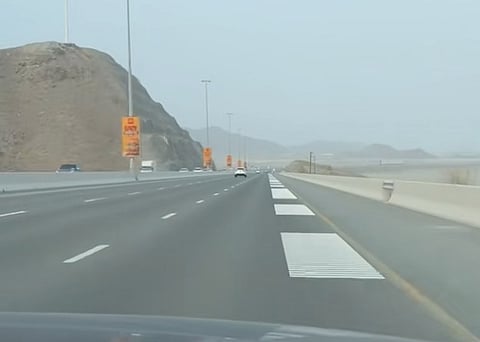Road goes viral: Fujairah rolls out Musical Road, here's how it works
Routine commute turns into a drive-through melodic experience of Beethoven’s 9th Symphony

The “musical road” in Fujairah, a unique stretch of Sheikh Khalifa Street, has become viral.
Why? It turns a routine commute into a drive-through symphonic experience.
This nearly 1-km-long installation, located just before the Fujairah Police Headquarters, is the first-of-its-kind in the UAE and the Arab world.
Specially-engineered “rumble strips” embedded in the road surface play a portion of Beethoven’s Ninth Symphony as cars drive over them at a steady speed.
Where is Fujairah?
Fujairah, one of the seven emirates comprising the United Arab Emirates (UAE), is about an hour away from Dubai by car.
The emirate is known for its beautiful beaches along the Gulf of Oman, the rugged Hajar Mountains, historical sites like Fujairah Fort and Al Badiyah Mosque, and its role as a major shipping and bunkering port.
What is the Fujairah 'Musical Road' made of?
The road features precisely spaced rumble strips, cut into or laid onto the asphalt.
At what speed does it work?
When a vehicle’s tires roll over these strips at the recommended speed (about 105 km/h), the vibrations produce musical notes.
How does it work?
The spacing and depth of the grooves determine the pitch and rhythm, allowing the road to “play” a recognisable melody — in this case, Beethoven’s Ninth Symphony.
This technique is based on the physics of vibration, where the frequency generated by the tire corresponds to musical notes, depending on the distance between the strips.
The road has clocked up virality on social media.
Where else can the same thing be found?
Musical roads have been created in several countries around the world, including:
Denmark: The world’s first musical road, the Asphaltophone, was built in Gylling in 1995 and played an arpeggio in F major.
Japan: Multiple “Melody Roads” play local folk songs and classical tunes.
South Korea: Roads play tunes like “Mary Had a Little Lamb” and traditional songs, often to keep drivers alert.
United States: California’s “Civic Musical Road” plays part of the “William Tell Overture”.
China: Roads in Beijing and other provinces play patriotic songs and classical pieces.
Hungary: Roads play national pop and folk songs, such as “67-es út” and “Nélküled”.
Other countries include Iran, Taiwan, Indonesia, Argentina, Belarus, Russia, France, and Turkey.
What is it for?
Musical roads serve several purposes:
Artistic and cultural engagement: They turn ordinary infrastructure into public art, offering a unique, interactive experience that delights both locals and tourists.
Tourism and local attraction: Musical roads attract visitors, boosting tourism and local pride. In Fujairah, people are making special trips just to experience the musical road.
Traffic safety: In some countries, musical roads are designed to encourage drivers to maintain a safe, steady speed for the best musical effect, which can reduce accidents caused by speeding or drowsiness. The musical feedback only works at the correct speed, subtly encouraging safer driving habits.
Community identity: By featuring globally recognized or local musical pieces, these roads can foster a sense of community and cultural identity.
The Fujairah musical road is a permanent, innovative blend of engineering and art, made from carefully spaced rumble strips that play a Beethoven tune.
Sort of like the road becoming a destination in itself, while also serving as a safety feature, and adding to Fujairah’s cultural landmarks.
Sign up for the Daily Briefing
Get the latest news and updates straight to your inbox





